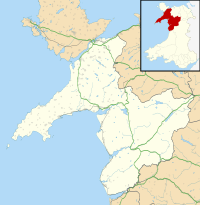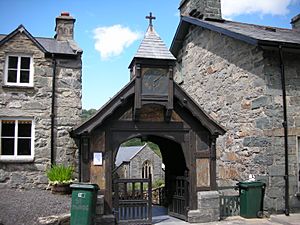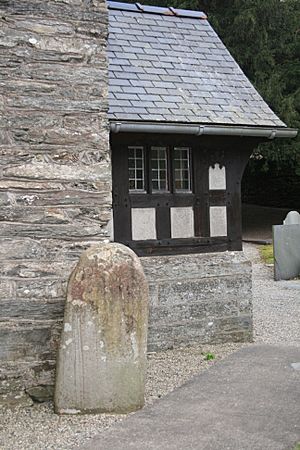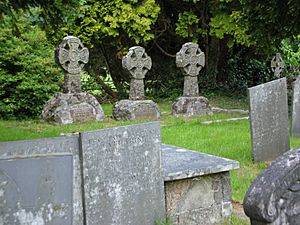St Twrog's Church, Maentwrog facts for kids
Quick facts for kids Saint Twrog's Church |
|
|---|---|
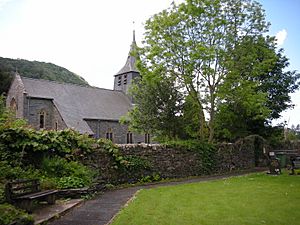
St. Twrog's Church
|
|
| Religion | |
| Affiliation | Church in Wales |
| District | Diocese of Bangor |
| Ecclesiastical or organizational status | Parish church |
| Location | |
| Location | Maentwrog, Gwynedd, Wales |
| Architecture | |
| Architect(s) | John Douglas |
| Architectural type | Church |
| Completed | 1896 |
| Materials | Granite, Slate roof |
Saint Twrog's Church is a historic church located in the village of Maentwrog, Gwynedd, in Wales. It sits in the beautiful Vale of Ffestiniog inside the Snowdonia National Park. Because of its historical importance, it is protected as a Grade II listed building. This means the building cannot be changed without special permission.
Contents
The Story of Saint Twrog
The church is named after Saint Twrog, who founded the first church on this site way back in the 6th century.
Who Was Saint Twrog?
It is believed that Saint Twrog was the son of a nobleman from Brittany, a region in modern-day France. He had several brothers who also became saints, including Saint Tanwg and Saint Tegai.
When Twrog arrived in the area, the valley was very marshy. He used the reeds and flexible branches (called wattle) from the marsh to build a small, simple hut or cell to live in.
The Legend of Twrog's Stone
Near the church door, there is a huge stone called Maen Twrog (maen is the Welsh word for stone). Legend says that Twrog threw this giant rock from the top of a nearby mountain called Moelwyn.
The stone flew through the air and crushed a pagan altar that was in the valley below. Pagans were people who followed ancient religions before Christianity became widespread. It is said that you can still see Saint Twrog's handprints on the stone. The village of Maentwrog is named after this famous stone.
Features of the Church and Churchyard
The church and its grounds have many interesting features that tell stories from its long history.
Ancient Yew Trees
The churchyard has yew trees that are thought to be over 1,300 years old. In ancient times, yew trees were seen as a symbol of eternal life because they stay green all year.
Yew wood was also very valuable for making longbows for soldiers. Because yew trees are poisonous, they were often planted in churchyards where they could grow safely away from people and farm animals.
Rebuilding the Church
The church that stands today is not the original one built by Saint Twrog. It was rebuilt several times over the centuries.
Before 1896, the church was dedicated to Saint Mary. This might be because Cistercian monks were once very active in the area. Nearby, there is a well called Saint Mary's Well and a lake called Llyn Mair (Mary's Lake).
A famous rector (a type of priest) named Edmwnd Prys served at the church from 1572 to 1624. He is remembered for translating the metrical psalms (religious songs from the Bible) into the Welsh language. A window in the church celebrates his work.
The 1896 Restoration
In 1896, the church was significantly rebuilt and restored. A new chancel (the area around the altar) and a baptistery (where baptisms take place) were added. New stained glass windows were also installed.
This work was paid for by William Edward Oakeley, a wealthy local landowner. His wife, Mary Oakeley, was a skilled artist who did the beautiful wood carvings inside the church. The architect for the project was John Douglas, who also designed the church's special covered entrance gate, known as a lych gate.
During the restoration, a new organ was installed, and the old church bell was moved to the village school.
Inside the Church Today
Inside, you can see memorials that were moved from the older church building. There is also a carving of Saint Twrog on the pulpit, the raised platform where sermons are given. A small piece of Edmwnd Prys's original pulpit is also preserved.
Outside in the graveyard, you can find three large memorials in the style of a Celtic Cross. These were built for members of the Oakeley family, who helped restore the church.
See also


